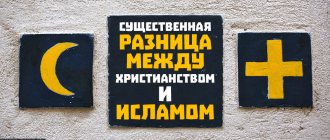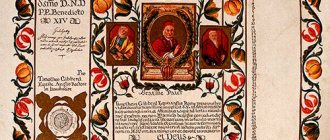In order to understand which religion dominates in Europe, just look at the largest historical Christian cathedral in the world - St. Peter's Basilica in Rome. The capacity of the cathedral is about 60,000 people, in addition, another 400,000 can gather in the area facing the balcony.
From this balcony, the Pope reads his messages to the City and the World. The main religion in Europe is Christianity. At the same time, all world religions and the majority of religious groups existing in the world are represented on the continent.
St. Peter's Basilica in the Vatican. St. Peter's Basilica is a symbol of European Catholicism. Photo: upload.wikimedia.org
Europe is a Christian continent
Europe is a part of the world in the Northern Hemisphere of the Earth, together with Asia it forms the continent of Eurasia. As of 2021, 745.8 million people live on its territory (about 10% of the Earth’s population).
There are 43 states in Europe, with 5 states only partially located in Europe. As for the religion of Europe, in European countries, according to the ratio of the number of religious groups on the continent, it is presented as follows:
43
there are so many states in Europe
- Catholicism - 35%;
- Orthodoxy - 26.7%;
- Protestantism - 13.7%;
- Islam - 5.2%;
- Buddhism - 0.4%;
- Hinduism - 0.2%;
- other religions - 0.8%;
- do not belong to any religion - 18%.
Political map of Europe.
In these countries, the main religions are Christian, namely Catholicism and Protestantism. Photo: deartravel.ru Thus, we can say that the dominant religion of Europe is Christianity. It should also be noted that the religious composition of Europe is diverse and all world religions are represented on the continent.
Christians are represented in all European countries, and in most countries of Western Europe there are groups of Jews who profess Judaism. As for Islam, it is practiced by small groups of the population of the Balkan Peninsula.
35%
so many Europeans consider themselves Catholics
Christianity in Europe is represented by several branches. The fact is that in the 11th century it split into the Western, Catholic and Eastern, Orthodox Church. The Catholic Church, subordinate to the Pope, maintained strict centralization.
At the same time, the Pope laid claim to supreme power throughout the Christian world. The Orthodox Church itself split into several national (autocephalous) churches, subordinate to secular kings and emperors.
In the 16th century, various “Protestant” denominations and churches began to break away from the Catholic Church, refusing to recognize the primacy of the pope. These were the followers of Calvin in Switzerland, Luther in Germany and other Protestants who greatly simplified religious rituals and worship.
Religious map of Europe, showing the four main groups of faiths: Orthodox, Catholics, Protestants and Muslims. Catholics are indicated in blue, Protestants - lilac, Orthodox - red, Muslims - green
Protestantism, in its various branches, especially spread in the central and northern parts of Europe. Currently, Catholicism dominates in Spain, Portugal, Italy, France, Ireland, Belgium, and Austria. The Catholic religion predominates among believers in Poland, Hungary, the Czech Republic, and Slovakia.
Protestantism in its various denominations and churches currently dominates in Norway, Sweden, Denmark, Iceland, Finland, and most of Germany. Orthodoxy has long spread from Byzantium to countries in the east and southeast of Europe.
France
The religious composition of the population of France looks like this:
- Do not identify themselves with any religion – 45%
- Catholics – 42%
- Muslims – 8%
- Other religions – 1% each Orthodox, Jews, Buddhists
Rice. 4. Notre Dame Cathedral (Notre Dame de Paris)
The French constitution states that it is a secular country. This means that recognizing any religion at the state level is prohibited. Whoever wants to believe in it.
In Europe, Catholicism is considered the state religion in three countries
Currently, Catholicism is considered the state religion in three countries: Liechtenstein, Malta, and Monaco. In addition, some Swiss cantons recognize this status. Moreover, the number of Catholics on the continent is 280 million people.
The Vatican is considered the unofficial capital of European and world Catholicism. The residence of the Pope, the head of the Catholic Church, is located here. The Vatican is a special state in Europe, since it is located on the territory of the capital of Italy, Rome, and power in it belongs to the Pope.
Sometimes Catholic churches are even sold as entertainment venues.
The modern Catholic Church in Europe is experiencing a crisis. The fact is that the majority of the European population declares their irreligion, and as a result, Catholic churches on the continent are closing.
The place of Catholicism is actively occupied by Islam, Protestantism, as well as new religious teachings. At the same time, the hierarchs of the Catholic Church have recently taken a course towards supporting modernism, which also negatively affects the popularity of Catholicism in Europe.
Germany
A common form of Protestantism is Lutheranism, founded by Martin Luther in the mid-17th century. The main church is Evangelical, where more than 24 million people attend, which is 30% of the country.
Another 30% are Catholics who attend Roman Catholic churches.
A large percentage of the population are atheists. Other religious minorities are also poorly represented.
Rice. 3 German Lutheran Church
Most Orthodox Christians in Europe live in Eastern Europe
On the European continent, Orthodox Christians live mainly in Eastern Europe. These are representatives of the Balkan peoples: Greeks, Bulgarians, Serbs, Montenegrins, Macedonians, Romanians and part of the Albanians. As for Russia, besides the Russians, Orthodox Christians are professed by the Chuvash, Mari, Udmurts, Komi, Karelians, Mordovians, Yakuts, some Ossetians and many others.
Church of St. Prince Lazarus, Birmingham (UK). In our time, Orthodoxy goes beyond the boundaries of its traditional regions of distribution in Europe. Photo: pravoslavie.ru
It is impossible to determine the number of Orthodox Christians in Europe, since in a number of countries where Orthodoxy traditionally spreads, state and church bodies do not keep records of Church members.
The number of believers in the canonical Orthodox churches is estimated at 227 million people as of 2013.
Recently, many Western Europeans have been converting to Orthodoxy.
The largest number of Orthodox Christians live in Russia: about 40% of all Orthodox Christians (including Old Eastern Orthodox Christians) in Europe.
European countries with a majority Orthodox population, according to censuses and surveys, also include: Belarus, Bulgaria, Greece, Georgia, Cyprus, Macedonia, Moldova, Romania, Serbia, Ukraine, Montenegro. Orthodoxy is also noticeably present in Bosnia and Herzegovina, Estonia, Latvia, Lithuania, Kyrgyzstan, Albania, Uzbekistan
Konstantin Simon, a Catholic priest and doctor of theology, who performed the rite of accession to the Orthodox Church. Nowadays in Europe there are frequent cases of Catholics converting to Orthodoxy. Photo: aquaviva.ru
As a result of migration, as well as the activities of Orthodox missionaries in the 20th century, Orthodox communities began to appear outside the traditional distribution of Orthodoxy.
As of 2010, the number of Orthodox Christians in Austria is 2.3% of the population, Spain - 2%, Germany - 1.4%, Great Britain - 0.9%, 0.6% each, Italy - 0.2% . In 2011, Orthodoxy became the fastest growing religion in Ireland, mainly due to the large number of migrant workers from Eastern Europe.
XX
in this century, thanks to migration and missionaries, Orthodox communities began to appear in Europe
Many Western Europeans in our time are converting to Orthodoxy, because they believe that it is closest to the earlier Christian tradition than all other branches of Christianity.
What have we learned?
The territory of Europe can be roughly divided into three parts: Western - completely Catholic, Eastern - Orthodox, but in the center and north Protestantism dominates. In Great Britain there are two state churches, in Germany a popular type of Protestantism is Lutheranism, and France is a free country, but the majority consider themselves Catholics.
Previous
GeographyRivers of Foreign Europe - the largest and longest navigable rivers on the map
Next
GeographyAgriculture in Foreign Europe - types and industries in the table
The birthplace of Protestantism is Western Europe
Protestantism arose in Western Europe in the 16th century. It is the third largest Christian denomination on the European continent. Today there are several thousand Protestant denominations.
This makes it difficult to count the number of Protestants in Europe. The number of some Protestant communities does not exceed 1 thousand people.
Among the largest are such religious associations as: the Church of England, which unites followers of the Anglican Church, Puritans, supporters of the teachings of Luther, who are united by the Lutheran Church.
Basel Cathedral. Europe is the birthplace of Protestantism. Photo: freecity.lv
Separately, it is worth noting such a religious association as the Evangelical Church in Germany. It unites the Reformed Church and Lutheran communities in Germany. In addition, Seventh-day Adventists, representatives of the Free Church and the Salvation Army, the Church of Scotland, etc. also operate in Europe.
The majority of Protestant believers are adherents of Lutheranism, Anglicanism, and Calvinism, while in Europe there are also small religious groups calling themselves Protestants. The number of their followers in different countries does not exceed 2 thousand people.
34 million
so many Protestants live in the UK, this is the largest number of Protestants in Europe
The most populous Protestant countries in Europe at the moment are Great Britain, where Anglicanism is practiced, the head of which is the English monarch (34 million), and Germany, where Protestant denominations are the most diverse (23 million).
A third of the Swiss, a fifth of the Dutch, and more than 80% of the population of the Scandinavian countries and Finland consider themselves Protestants. More than a million Protestants live in France, Hungary and Romania. In historically Lutheran Estonia and Latvia, only every fifth person considers themselves a Lutheran, while in Estonia 40%, and in Latvia just over 50% of the country's population, consider themselves to be a Lutheran.
Modern multi-religious Europe
Europe cannot be called mononational, since throughout its history it has received flows of emigrants more than once. This fact turned it into a multi-religious one. However, in the twentieth century their number began to increase rapidly. This is due to the political situation in the world, as well as the favorable policies of European countries for migrants.
Today there are on average about sixty different peoples. And although Christian values dominate culturally and spiritually, other ethnic groups also influenced these indicators. Thus, the religious composition of Europe was replenished with new ones.
Among them:
- Islam;
- Hinduism;
- Buddhism;
- Chinese religion;
- Baha'ism;
- Confucianism.
As an example of a monoreligious state, we can mention the Vatican. This tiny land is the cradle of Christianity. Here is one of the largest Christian churches in the world. It's called St. Peter's Basilica. An interesting fact is that the altar in the temple is located uncharacteristically for Christian traditions. Instead of east, it faces west.
More
Islam is the fourth largest religion in Europe and the fastest growing
Why is religion needed?
Islam appeared in Europe as a result of Muslim conquests in the 8th century. This was mainly the Iberian Peninsula and parts of Southern France. The further spread of Islam is associated with the spread of Turkish influence in the Balkans and Central Europe.
In recent years, Muslims have migrated to Europe as residents and temporary workers. It should be noted that due to the migration process, Islam shows great potential for growth in Europe, which is negatively perceived by residents of European countries.
The dispute between a Muslim and an opponent of the Islamization of Europe. The growing number of Muslims these days does not please the native inhabitants of Europe. Photo: ansar.ru
According to the Pew Forum, the total number of Muslims in Europe in 2010 was approximately 44 million (6%), excluding Turkey. While the total number of Muslims in the European Union in 2007 was 16 million (3.2%).
Muslims make up 99% of the population in Northern Cyprus, over 98% in Turkey, 90% in Kosovo, 40% in Bosnia and Herzegovina, 56% in Albania, 33% in Macedonia, 19% in Montenegro, between 10 and 15% in Russia , 9% in France, 8% in Bulgaria, 6% in the Netherlands, 5% in Denmark, just over 4% in Switzerland and Austria, between 3 and 4% in Greece and almost 5% in the United Kingdom and Germany.
44 million
or 6% of Muslims lived in Europe as of 2010
Judaism, Buddhism and Hinduism as world religions are also represented in Europe
All world religions are represented in Europe, including Judaism, Buddhism and Hinduism. Judaism has always been quite widespread across the European continent.
As a result of the persecution of Jews and especially the Holocaust perpetrated by Nazi Germany during World War II, the Jewish population of Europe declined significantly. Today, the largest Jewish community lives in France.
Its population represents 1% of the total population (between 483,000 and 500,000 Jews). Other countries with large Jewish populations are Great Britain and Russia with 291,000 and 194,000 people respectively.
Memorial to the Murdered Jews of Europe in Berlin, Germany. As a result of the Holocaust, the size of the Jewish community in Europe decreased significantly. Photo: upload.wikimedia.org
As for Buddhism, it has recently begun to spread throughout Europe. Today there are 3 million supporters of this religion. Most of them live in Kalmykia.
Hinduism is widespread mainly among Indian immigrants. His following has also grown rapidly in recent years, especially in the UK, France and the Netherlands. In 1998 there were approximately 1.4 million Hindu supporters in Europe.
As a result of the Holocaust, the Jewish community in Europe was significantly reduced.
Indian emigrants also brought Hindu religions such as Jainism and Sikhism to the European continent. Jainism is common in Belgium and Britain. The number of supporters of this religion does not exceed 3 thousand people.
As for Sikhism, about 1,000,000 people live in Europe. Most of the community lives in the United Kingdom (750,000) and Italy (70,000). Approximately 10,000 in Belgium and France.
The Netherlands and Germany have Sikh populations of 12,000. In all other European countries, no more than 5 thousand Sikhs live.
Atheism is strong in Europe
There are other religions in Europe, for example, Baha'is, Jehovah's Witnesses, neo-pagans, etc. It should be noted that the continent is characterized by a high level of agnosticism and atheism.
51%
as many Europeans as of 2010 believed in God, 26% - in a higher power, 20% - in nothing
Such trends began to emerge in the 20th and 21st centuries. As of 2010, 51% of Europeans "believe in God", 26% believe in "some kind of spirit or life force", and 20% had none of these forms of belief.
Proportion of atheists in Europe by country in 2005. Europe is characterized by a high proportion of atheists. Photo: upload.wikimedia.org
In addition, 7% of EU citizens consider themselves atheists. However, there is a significant difference between residents of different European countries. For example, 94% of Maltese consider themselves believers, while among residents of the Czech Republic the number of believers does not exceed 16% as of 2010.
7%
so many EU citizens consider themselves atheists
It's also worth noting that many Europeans have official religions, including Liechtenstein, Malta, Monaco, Vatican City (Catholicism); Greece (Eastern Orthodoxy); Armenia (Apostolic Orthodoxy); Denmark, Iceland and Great Britain (Anglicanism).
By leaving a comment, you accept the user agreement











